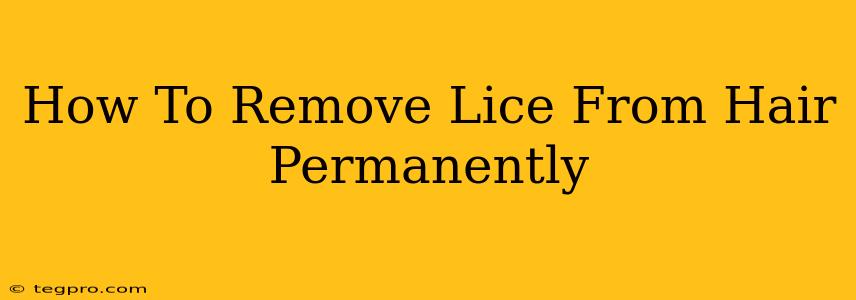Dealing with head lice is incredibly frustrating, but knowing how to remove them permanently is key to regaining peace of mind. This comprehensive guide provides effective strategies for eliminating lice and preventing their return. Remember, consistency and thoroughness are critical for success.
Understanding Head Lice
Before diving into removal methods, let's understand what we're dealing with. Head lice are tiny insects that live and feed on human blood. They're highly contagious, spreading easily through close contact. Identifying them is the first step. Look for:
- Nits: These are lice eggs, small white or light-colored oval specks firmly attached to the hair shaft, close to the scalp.
- Nymphs: These are immature lice, smaller than adults but still visible to the naked eye.
- Adult Lice: These are approximately the size of a sesame seed and are usually grayish-white.
Effective Lice Removal Methods
Several methods exist, but a combined approach usually yields the best results. It's crucial to treat everyone in the household who might be infested.
1. Manual Removal: The Nitpicking Process
This is the most labor-intensive but often the most effective method, particularly when combined with other treatments. You'll need:
- Fine-toothed comb: A specialized lice comb with closely spaced teeth is essential for removing nits and lice.
- Good lighting: A bright light helps you see the tiny critters.
- Conditioner: Apply a generous amount of conditioner to the hair to make the combing process easier.
Process:
- Section the hair: Divide the hair into small sections to ensure thorough combing.
- Comb meticulously: Work your way from the scalp to the ends of each section, repeatedly combing through the same area to dislodge nits and lice.
- Clean the comb: After each section, wipe the comb clean on a paper towel to remove the removed lice and nits.
- Dispose of lice and nits: Dispose of the collected lice and nits in a sealed bag.
Important Note: Be patient and persistent! This process may take several hours, but it's crucial for complete removal.
2. Chemical Treatments (Over-the-Counter Medications)
Over-the-counter lice shampoos and lotions containing permethrin or pyrethrin are widely available. Always follow the instructions carefully. These treatments kill adult lice, but they may not kill all the nits, so combing remains essential.
Important Considerations:
- Repeat treatments: Often, a second treatment is needed after 7-10 days to kill any newly hatched lice.
- Allergic reactions: Some people experience allergic reactions to these chemicals. Test a small area before applying it to the entire scalp.
- Resistance: Lice can develop resistance to certain chemicals, making the treatment less effective.
3. Natural Remedies (Use with Caution)
Some people explore natural remedies like tea tree oil or vinegar. While some anecdotal evidence suggests effectiveness, scientific evidence is limited. These remedies should be used cautiously and often need to be combined with other methods for complete effectiveness. Always test a small area for allergic reactions before widespread application.
Preventing Lice Reinfestation
Preventing recurrence is just as important as removal. Here are some tips:
- Regular checks: Regularly check your hair and your family's hair for lice and nits.
- Avoid head-to-head contact: Discourage children from sharing hats, combs, brushes, or other headwear.
- Wash bedding and clothing: Wash all bedding, towels, and clothing in hot water (at least 130°F) to kill any remaining lice or nits.
- Vacuum frequently: Vacuum all carpets, upholstery, and other areas where lice might have fallen.
When to Seek Professional Help
If home treatments prove unsuccessful or the infestation is severe, consult a doctor or a specialist. They can recommend stronger treatments or provide additional guidance.
Remember, persistence and a multi-pronged approach are key to effectively and permanently removing head lice. While frustrating, with diligent effort, you can overcome this challenge and restore your peace of mind.

